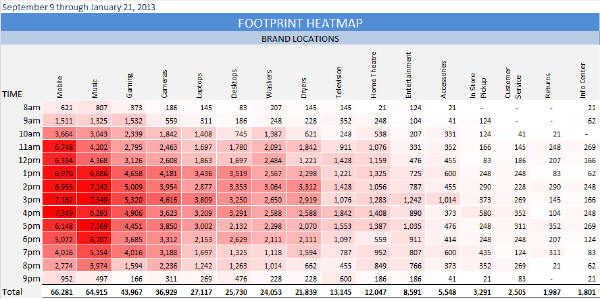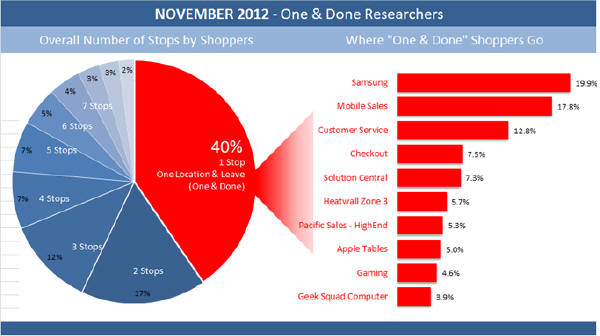Directions Magazine (DM): Your company offers indoor location analytics for retailers. What do you install at the physical retail location, what data does it collect on customers and how is it recording the data?
Jonathon Rosen (JR): [Refer to Figure 1 below) WirelessWERX aggregates and analyzes indoor traffic via patented mobile sensor technology. Our system “sees” customers and other indoor traffic who carry mobile phones in a completely anonymous manner. Discreet sensors (about the size of a deck of cards) are placed strategically throughout the store. The devices are set to create zones that mirror department or sub-departmental structures. The flexible zones can cover a broad range of sizes and shapes—down to as small as three square feet. We, or our partners, design these precise zone parameters with the customer.The devices network to each other and transmit anonymous data to a WirelessWERX Base Station. The Base Station transmits the anonymous data to our servers, where we process the information and deliver it in the form of aggregate reports and data feeds to customers’ applications.We process data in real-time. We typically deliver reports via online dashboards or through email. These reports may include queue reporting, departmental conversion reports across the chain and by store, staffing reports and heatmaps based on traffic by hour and day, marketing and merchandising analytics, traffic path maps and more.We are conscious of the evolving privacy debate and are proud to have designed a product that provides valuable insights while protecting consumer privacy.
JR: WirelessWERX believes in the importance of protecting consumer privacy. WirelessWERX solutions protect consumer privacy while empowering retailers with tools to improve the shopping experience and compete more effectively.WirelessWERX’ technology is designed to protect individual privacy and is completely anonymous, and our systems never receive information about the consumer. When a shopper carrying a mobile device (smartphone, tablet, etc.) walks within range of a WirelessWERX sensor, the sensor recognizes the MAC address, scrambles it, and only uses the new, anonymous ID. We use the data to see aggregate shopping information and repeat visits without connecting the data to the device or device-holder.WirelessWERX shares insights about cumulative shopper traffic with retailers to help them better understand how staffing, merchandising, and marketing changes affect general traffic. Using WirelessWERX’ solutions, retailers can improve the shopping experience without being invasive or intrusive.Our solutions helps retailers operate more efficiently, stay competitive, and serve their customers better.
- Our sensors receive only the MAC address, manufacturer code (Apple, Samsung, etc.), and signal strength.
- We do not receive any information whatsoever about the mobile device owner.
- We never share information on individual devices.
- We never link data to specific individuals.
- We never share information between our clients.
JR: [Refer to Figures 2 & 3 below] We sample anonymous traffic data and then compile it in detailed aggregated analytics. This information helps retailers improve the customer experience by identifying specific ways to optimize their business.Retailers rely on aggregate traffic data, such as departmental conversion, departmental traffic by hour and day, shopping patterns, shopping segment time, repeat traffic, first location of visit and dwell times to better understand and serve their customers. Detailed, regular analysis of in-store behaviors (pathing and dwell times) yields critical leanings that support existing business processes and deliver new actionable insights. We make data available in real-time, but our customers use a mix of real-time and post-behavior reporting.Reports can include:Discrete Shopper Behaviors
- Visit vs. buy – departmental conversion
- First visit location – intent
Shopper Segmentation – Repeats
- Exact shopping patterns
- Floor plan effectiveness
- Sequential merchandising
- Staffing by department
Applications
- Analyze and understand in-store shopper behavior
- Measure departmental traffic and conversion rates
- Determine first visit and shopper intent
- Quantify first and repeat shopper visits
- Identify repeat visits and purchase intent
- Quantify traffic density and trends over time
- Compare data before and after testing merchandising tools
- Quantify total store passersby versus actual store visitors
- Quantify traffic density within specific in-store zones throughout the day
- Measure and compare dwell time averages for each zone
- Identify “One-and-Done” behavior to reduce potential showrooming
- Quantify effectiveness of signage and displays for MDF and Co-op programs
- Improve labor efficiency
Figure 2. "One & Done" Shoppers Chart (Click for larger image)
Figure 3. Total Store Traffic (Click for larger image)
JR: We can customize the location intelligence platform for retailers. Our technology is a big WirelessWERX differentiator and we see our deep skill-sets in reporting and analytics as a significant opportunity to deliver value. Our most frequent requests are custom reports and custom report delivery. Real value takes place when we integrate these data into key business processes.The most common customization our clients request is that we create business rules that take employees out of the traffic reports. Virtually every customer asks us to make sure we don’t count employees or delivery people and we can set those rules in just a few moments (i.e., if a device is in the store for more than four hours or comes in through the back door, do not count them—ever).The next most common request is that we deliver custom reports. We are often asked to deliver new reports that fit old or new processes. Our online traffic and other reports are user-customizable by selecting custom date ranges, locations or departments.Another frequent request is for queue management – custom delivery of wait times at the register to help managers schedule their employees. We might be asked for unique, exciting reports that have exceptional value, such as reports where the chain defines a wait-time limit, such as two minutes. Based on wait-time data, we can then suggest how many registers need to be open for each shift in order to meet specified standards.
JR: That is a great question! We are in the early stages of this market. Virtually every retailer is aware at a category level that this type of solution is out there, and that is a 10x change over just a year ago! However, since it is early we see many levels of understanding, and we find ourselves in an educational role in every instance. That is good – it is how we learn the most about retailers’ needs and differences.We are almost certainly the most accurate solution on the market, but customers often ask for too little. Business rules at most retailers are applied by department and by brand. A location technology needs to segment shoppers precisely by department—and even by brand—to be most effective.That works in our favor; we can accurately “geo-fence” or segment behavior in any department–even a space as small as an end-cap. However, most customers ask for less accuracy and flexibility. We steer them toward the data that are most precise and lead to faster, more definable value and return on investment (ROI).Another key issue is assisting the retailers with their selection criteria. We hear requests such as “I really want to use my existing hardware to save money,” but it turns out that new hardware might better suit their needs and actually be less expensive. Most often we counsel our customers that their selection criteria should include accuracy, data integrity, zone flexibility, privacy protocols, ease of ownership (how to manage the movement of zones) and, of course, price. We always find ways to use location technology that may not have occurred to our customers. We take a partnership view of our role with our customers, which works very well for everyone.Our clients’ primary goal is to improve the shopping experience—aggregate shopper behavior. Where shoppers go, what paths they take to get there, how long they stay, and when and where they come back are the kind of robust data our customers depend on to guide the choices they make. Our mission is to generate these actionable insights to help our customers make smart, high-value business decisions.
JR: There are several primary opportunities, such as the following:
- Door Counters: Where door counters count overall visitors, we count indoor visits—down to how many shoppers traffic specific departments, or even end caps. The largest door counting companies in the world use WirelessWERX solutions, and we can integrate with others.
- Human Resources/Scheduling: Many sophisticated scheduling applications have a “plug-in” for data that inform the schedule. Since we count the number of visitors in each department by time and day, we deliver exceptional value to make these applications even more useful, accurate and expense-saving while better serving the shoppers’ needs.
Because we can accurately manage register queues, our ability to inform schedules for cashiers has an immediate and measurable impact on customer service.- General Retail Business Intelligence: As a rule, we encourage integration to our clients’ systems, and we add value in so many ways. We make it as easy as possible for retailers to integrate aggregate traffic insights into their existing business processes.
JR: We are an engineering innovation company that will continue to grow and expand our technology as we have for many years. Sensor and radio modalities will change with time, and we will continue to adapt. Our principles of value start with accuracy, flexibility and extensibility. We focus on technologies that help retailers operate more efficiently, stay competitive and serve their customers better.We are also a solutions company. The software we develop is at the core of the value we deliver. We have over 24 patents in location services. We are constantly building new location software and reporting tools that deliver real value to our customers. The rubber meets the road at our ability to inform clients with location data in a meaningful way. We provide our customers with exceptional reports that are actionable, whether it’s traffic data alone or traffic data integrated with other datasets. Every hour we spend developing these solutions pays off in new reports, new vertical markets and new value propositions. As a result, we generate new partnerships within new verticals and with other leading tech companies every month. This means that some of what we develop will be dynamically generated with others in the ecosystem.Our founding engineers led the NASA GPS satellite programs. To this day, we have more engineers than any other employees. We are a company with expertise in virtually every commercial sensor modality there is, both indoor and out. There is some irony in the fact that we are as likely to deliver simple solutions as we are complex ones.We have an innovative product that helps both consumers and retailers. This has led us to focus on practical, high-value deliverables. Sometimes, things we do very well are not practical. One good example is triangulation. We excel in triangulation, but we know that our customers need to manage and live with these systems for years. Additionally, in many cases, triangulation creates an unmanageable burden when the client changes its interior layout. So we came up with a practical alternative. We now deliver proximity solutions more often and we put thousands of hours of development into software that makes proximity solutions work incredibly well.


